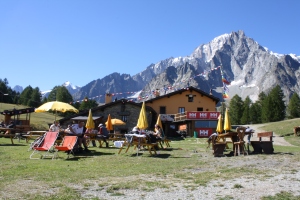I first learned of the Tour du Mont Blanc (TMB) a couple of years ago. My husband Derek and I had decided to make extended hiking a core part of our annual vacation, and I was looking into well-known walks around the world. I stumbled upon a Wall Street Journal article that was enticing, if daunting.
After some additional research, Derek’s curiosity was officially piqued. As we began planning our 2014 vacation, he was insistent that we do the Tour. I still wasn’t convinced. With only two weeks to travel, I wasn’t so keen on spending the vast majority of it tromping through the mountains. When I agreed to do more hiking on our trips, I was thinking of three to four days – not 10! Of course, he knows where my weaknesses lie, and when he floated the idea of spending a couple of days in Paris (my favorite city) on the front end of the trip, I was in.
But how do you begin to plan for a 100-mile hike with multiple locations from which you can begin, various distances you can walk each day and a broad selection of overnight accommodations from which to choose? Despite the TMB’s popularity, I found clear and informative recommendations for planning the trip surprisingly difficult to find.
One popular site hosted by a TMB veteran provides helpful information on equipment and recommendations for traveling to the area, among other issues, but I found essential matters – such as a suggestion of point-to-point hiking for each day and accommodation recommendations – to be overwhelming or non-existent. For my purposes, I found two sites to be most helpful and they served as the basis for planning our itinerary.
The first is a seemingly “official” TMB site run by an association of refuge caretakers. Specifically, I found the “Create Your Route” feature to be useful. This tool allows you to enter your departure location, date and the direction you’re hiking (the TMB can be approached in a clockwise or counter-clockwise direction, with counter-clockwise being the traditional route) before directing you to an interactive map that provides approximate hiking times between points with accommodation options along the way, many of which can be reserved directly on the site.
The second resource I most utilized was Dave and Brenda’s blog chronicling their second journey on the TMB. While we did not follow their itinerary completely, I referred to it enough in planning our own trip that a joke soon emerged between Derek and me when discussing various legs of the hike. “Well, Dave and Brenda said that section was pretty tough.” “Dave and Brenda didn’t stay here.” “What did Dave and Brenda say about that?”
Finally, while I didn’t actually purchase the book in time for planning our route, the Kev Reynolds Cicerone Guide is absolutely essential for the hike. Our itinerary did not directly reflect the one outlined in the book (and, in fact, I would advise against following his recommendations for some portions – more to come on that), and we didn’t really reference the guide for directions – the path is very well waymarked. Instead, it provides an idea of what to expect each day and includes landmarks and other notes to help orient hikers along each leg.
While it may seem like there is an abundance of resources available for planning a TMB trip, I spent a significant amount of time culling small details from multiple sources and seeking out an elusive all-encompassing guide. While I am grateful to the resources I most utilized (I don’t know how I could have done it without Dave and Brenda!), I believe the knowledge gained from my own journey could be helpful to others planning a similar trip.
I encourage you to review my TMB-related posts for detailed suggestions on planning your trip, as well as a recap of my journey. If you have any questions or would like more information on any topic, please just ask!


